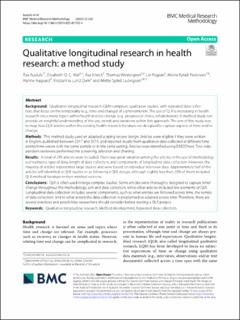Qualitative Longitudinal Research in Health Research: A Method Study
Audulv, Aasa; Hall, Elisabeth O. C.; Kneck, Åsa; Westergren, Per Christer Thomas; Fegran, Liv; Pedersen, Mona Kyndi; Aagaard, Hanne; Dam, Kristianna Lund; Ludvigsen, Mette Spliid
Peer reviewed, Journal article
Published version
Permanent lenke
https://hdl.handle.net/11250/3025226Utgivelsesdato
2022Metadata
Vis full innførselSamlinger
Originalversjon
Audulv, A., Hall, E. O. C.,Kneck, Å., Westergren, P. C. T., Fegran, L., Pedersen, M. K., Aagaard, H., Dam, K. L. & Ludvigsen, M. S. (2022). Qualitative Longitudinal Research in Health Research: A Method Study. BMC Medical Research Methodology, 22, 1-19. doi: 10.1186/s12874-022-01732-4Sammendrag
Background: Qualitative longitudinal research (QLR) comprises qualitative studies, with repeated data collection, that focus on the temporality (e.g., time and change) of a phenomenon. The use of QLR is increasing in health research since many topics within health involve change (e.g., progressive illness, rehabilitation). A method study can provide an insightful understanding of the use, trends and variations within this approach. The aim of this study was to map how QLR articles within the existing health research literature are designed to capture aspects of time and/or change. Methods: This method study used an adapted scoping review design. Articles were eligible if they were written in English, published between 2017 and 2019, and reported results from qualitative data collected at diferent time points/time waves with the same sample or in the same setting. Articles were identifed using EBSCOhost. Two independent reviewers performed the screening, selection and charting. Results: A total of 299 articles were included. There was great variation among the articles in the use of methodological traditions, type of data, length of data collection, and components of longitudinal data collection. However, the majority of articles represented large studies and were based on individual interview data. Approximately half of the articles self-identifed as QLR studies or as following a QLR design, although slightly less than 20% of them included QLR method literature in their method sections. Conclusions: QLR is often used in large complex studies. Some articles were thoroughly designed to capture time/ change throughout the methodology, aim and data collection, while other articles included few elements of QLR. Longitudinal data collection includes several components, such as what entities are followed across time, the tempo of data collection, and to what extent the data collection is preplanned or adapted across time. Therefore, there are several practices and possibilities researchers should consider before starting a QLR project.
Beskrivelse
The images or other third party material in this article are included in the article’s Creative Commons licence, unless indicated otherwise in a credit line to the material. If material is not included in the article’s Creative Commons licence and your intended use is not permitted by statutory regulation or exceeds the permitted use, you will need to obtain permission directly from the copyright holder.

